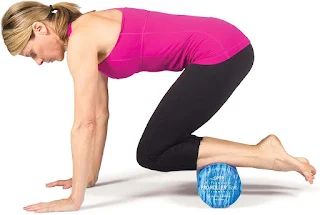Foam rollers can help you get rid of nagging muscular aches while also preventing discomfort and soreness. To help with those annoying pre-and post-workout kinks, make sure you purchase the appropriate foam roller for your needs.
Many doctors advocate foam rolling to their patients. It can aid in the relief of back discomfort. However, how to choose the right foam roller is crucial. From white to black, there is a range of treads, bumps, and vibration options to choose from.
You can give yourself a deep-tissue massage with foam rollers. The procedure allows you to stimulate and relax your muscles by using your own body weight, which is perfectly controlled. Although using the roller can be unpleasant, rubbing knots may help your muscles loosen their grasp. Foam rolling has been reported to improve range of motion, blood flow, and recuperation time in some athletes.
What are the advantages of the foam roller?
Foam rolling is a form of self-myofascial release that helps to relieve muscle tension. Flexibility, muscular tension, performance, and circulation have all been shown to improve with foam rolling. Both before and after a workout, this is a great option. It's yours to use whenever you choose. It's a great way to warm up, but it's also a great way to help relax your muscles after a hard workout.How to Choose a Foam Roller
Choosing the right foam roller for you isn't as simple as you may think, but it's crucial. Effectiveness, usability, and compliance can all be improved by selecting the correct roller. You can use a foam roller to relieve muscular knots on the back, hips, legs, arms, and other regions of the body using the pressure provided by your own body weight.
A foam roller can also aid with core stability and balance. The size, shape, foam type, construction, and pricing of foam rollers vary. You can get the best outcome by establishing your precise usage for the foam roller and then purchasing a foam roller that meets those demands.
Rollers are available in a range of sizes, from 3-4 cm to 90 cm. I recommend getting a roller that is the length of your back, so you can use it from top to bottom. As a result, a 24-35-inch roller should suffice, as a longer and tougher roller will cost more.
The density of Foam Roller
Foam rollers are available in a variety of densities, which affects how successful they are in deep-tissue massage. Using a roller that is too soft can result in insufficient pressure, while using a foam roller that is too harsh can result in bruising and trauma, causing pain and influencing your performance. If this is your first time using a foam roller, go for one that is a little softer. You can advance to a denser roller as your technique improves, and your muscles adjust. The density of a roller can be determined by its color, with white being the softest and black being the toughest. The density of blue and red rollers is normally medium. However, this varies by brand.Surface Texture of Foam Roller
Some rollers have ridges and knobs that let you apply different pressure strengths and give a more targeted massage. The other rollers' smoothness is obvious.
Smooth rollers:
This fundamental design distributes pressure evenly throughout the roller's length. Because the pressure is not as severe as with a textured roller, a smooth foam roller is a wonderful choice for someone who is just getting into rolling. Additionally, flat foam rollers are less expensive than textured rollers.
Rollers with a textured surface:
A foam roller with ridges and knobs that mimic the hands of a therapist can provide a more precisely targeted massage to work out knots in your muscles. Many rollers come with a range of textures to help you find the perfect amount of pressure.For intermediate firmness and endurance, choose an EVA foam roller.
EVA foam rollers are gaining popularity. They are frequently green in color. EVA rollers are relatively firm and provide a more comfortable, warm-to-the-touch surface.
Size and Shape of Foam Roller
Foam rollers come in a variety of sizes and forms.
Length:
- Long rollers (about 36 inches) are versatile and a wonderful initial foam roller. Because they are long enough to span your full-back when putting perpendicular to your spine, they are beneficial to your back.
- When working on your quads, hamstrings, and other body regions, they're also more stable than shorter rollers.
- Shorter lengths (about 24 inches) are ideal for smaller areas such as the arms and calves.
- The shortest lengths (between 4 and 12 inches) are ideal for portability and workout settings with limited floor space.
Diameter:
Foam roller with a half-circle shape:
Sticks with foam-covered roller massagers:
Balls of foam:
For a more intense massage, choose a roller with dimples.
Foam rollers that vibrate
Let's start by choosing a color or texture
Tips for using a foam roller
Consult your doctor for assistance in selecting and using a roller
At the gym, get to know how to utilize your roller
Use it to massage your tissues
 |
| Yoga Foam Roller |







